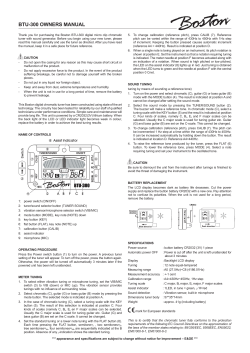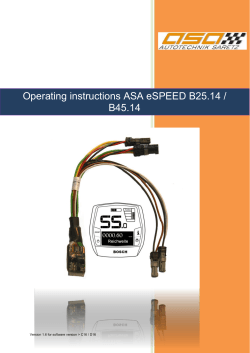
Operating Guide
TM Operating Guide Battery door: To open, push up, then lift off. Back Front Tuning with the Zoid 1. Clip the Zoid on your instrument and press the POWER [I/O] button for 2 seconds to turn on the Zoid. Push momentarily to turn off. 2. Choose your tuning mode by pressing the I/O button again for 2 seconds - this toggles Clip or Mic tuning modes. When Clip is displayed in the LCD the Zoid is getting its tuning signal through the clip. Use this mode when tuning your instrument – noise from the room will not effect the tuner. When Mic is displayed in the LCD the Zoid is getting its tuning signal from the built-in microphone. Use this if you want to tune an instrument without clipping on the Zoid. 3. Play the note or string you wish to tune. The played note will appear in the center of the LCD. (See the Tuning Tips for more information.) 4. Watch the tuning meter and adjust your note until the needle indicator lines up with the center of the dial. 5. The Zoid gives two visual cues for tuning: the needle indicator and the backlit LCD. The LCD lights up in Orange when your note is flat or sharp. When you are in tune the LCD lights up in bright Green. Adjust your instrument until the needle centers on the display and the LCD lights up in Green. Flat Tuning with the Zoid Use Flat Tune to quickly transpose your guitar down from standard tuning — great for those dark-n-heavy Eb and D tunings. Press the FLAT button to choose how many 1/2 steps flat you want to tune. The Zoid displays flat signs (b) below the FLAT section on the LCD. To flat tune your guitar down four half tones, press the FLAT button four times - the display will read as shown at right. To return the tuner to standard tuning, press the FLAT button until the flat signs are all gone. Mic Tuning Mode Clip Tuning Mode bbbb Flat Tuning Mode Calibrate the Zoid: Press the CAL button until the desired frequency appears under CALIB in the LCD (example given at right: 444 Hz). The tuner’s scale is now shifted to that pitch. To return the tuner to standard A = 440 Hz, press the CALIB button until 440 Hz appears. Calibration Limited Two-Year Warranty Zoid Features Stringed Instrument Tuning Tips If your Zoid Tuner fails because of a manufacturing defect within two years from the date of the original purchase, please return it to your dealer. If you need to return the tuner to Sabine, call for a Return Authorization number. Then send it, postage prepaid, to Sabine for replacement with a new or reconditioned product. You must include your full name, address, proof of purchase and the nature of the defect. This warranty does not cover damage caused by accident, misuse or defective batteries. Chromatic, Automatic Two-color LCD with simulated needle display, +/- 50 cents Contact pickup in clip Mic for acoustic tuning Manual calibration, 433 to 447 Hz 6-octave tuning range (A0 to B7) Auto shut-off after 3 minutes with no signal Pluck one string at a time. Mechanical Dim. (without clip): 2.37 x 1.5 x 0.55 in; 6 x 3.8 x 1.3 cm Do not pluck loudly. You will get the best results with light to medium plucking volume. Register your Sabine products online at: www.Sabine.com Weight: 1.3 oz. (37 grams) Battery One CR2032 3V Lithium (included) SABINE, INC. 13301 Highway 441 Alachua, Florida 32615-8544 USA (386) 418-2000 • FAX: (386) 418-2001 Memory All settings recalled from power-down www.Sabine.com Z-1000-OpGuide-080730.indd - rr Pluck the instrument once per second to keep the note “fresh” while you are tuning. Notes go noticeably flat a second or two after being plucked. If tuning a higher-pitched instrument (such as a mandolin), pluck a little faster; for a lower-pitched instrument (such as a bass), pluck slower. Pluck the strings with the flesh of the thumb. Fingernails and flat picks add overtones and slow the tuning process. Tune from a pitch that is flat up to the pitch you desire. This procedure removes any slack in the gears of the instrument’s tuning heads. If you tune from sharp to in tune, the gears will slip as you play, and the instrument will go flat after a few minutes of playing. If you have difficulty getting a note to register on the tuner, try touching the other strings lightly to stop their sympathetic vibrations. This will eliminate any extraneous overtones that may disturb the tuning. Use good strings. Old strings lose their uniformity and do not vibrate evenly. New strings stretch flat as you play. All sources of friction cause tuning problems. For example, if the slot in an instrument’s nut is too tight, the string will be pulled flat as it is played. A tight nut (or capo) will cause the string’s pitch to change in steps rather than evenly. Avoid pressure on the instrument while tuning. Even moderate pressure on the neck of a guitar will cause a noticeable change in pitch. Also, press the strings straight down to the fingerboard. Bending the strings sideways is very common, especially on difficult chords, but causes the strings to be pulled sharp. A note for advanced fretted instrumentalists: Almost all fretted instruments, and most other instruments, are constructed to play an “eventempered scale.” Sabine tuners are also calibrated to this scale. The even-tempered scale places equal tonal spacing between all notes in the scale so that the musician will not have to retune to change keys. A disadvantage, however, is that the third note of the scale sounds a little sharp (14 cents, to be exact). For example, when playing in the key of G, the B note will sound sharp. If you tune the B string so that it sounds correct in an open G chord, other chords using the B string will sound out of tune. You may choose to optimize the tuning of a particular key or to use the even-tempered scale. Much depends on your style, but generally it is best to tune exactly as your Zoid indicates. Made in China © 2008 Sabine, Inc.
© Copyright 2025





















